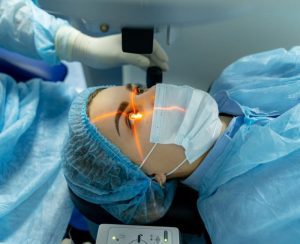Astigmatism is a common vision condition characterized by an irregularly shaped cornea or lens that causes blurred or distorted vision. This refractive error has driven many to seek the most effective corrective solutions, with laser eye surgeries such as PRK (Photorefractive Keratectomy) and LASIK (Laser-Assisted In Situ Keratomileusis) gaining popularity.
If you’re considering these options, it’s essential to be informed about both procedures to make the best decision for your eyes. In this blog post, we’ll discuss the differences between PRK and LASIK, particularly for astigmatism patients.
Understanding Astigmatism
Before we compare PRK and LASIK, it’s important to have a clear understanding of astigmatism.
Within your eye, the cornea and lens focus light to create an image on the retina. In a perfect scenario, the cornea and lens have a symmetrical round shape, much like a basketball. In astigmatic eyes, they often resemble the shape of a rugby ball, leading to multiple focus points that result in blurred vision at all distances. It can accompany other refractive errors like nearsightedness or farsightedness.
Traditional eyeglasses or contact lenses are the most common corrections, but for permanent treatment, many turn to refractive surgery.
| PRK | LASIK | |
| Procedure | Epithelial removal, corneal reshaping with laser, bandage contact lens | Corneal flap creation, reshaping with laser, flap repositioning |
| Flap Creation | No | Yes |
| Recovery Time | Longer (weeks to months) | Faster (days to weeks) |
| Initial Discomfort | More | Less |
| Suitability for Thin Corneas | Yes (preferred) | No (not recommended) |
| Risk of Flap Complications | None | Potential (dislocation, infection) |
| Long-Term Corneal Stability | Potentially stronger bond | Weaker due to flap creation |
| Dry Eyes | Less likely to worsen | May worsen a pre-existing condition |
PRK for Astigmatism
PRK was the first type of laser eye surgery for vision correction and is a precursor to LASIK.
Procedure
In PRK, the eye surgeon removes the surface layer of the cornea (the epithelium) and then reshapes the underlying corneal tissue using an excimer laser. This process corrects the curvature of the cornea, aiming to accurately focus light onto the retina. This step corrects astigmatism along with other refractive errors. Finally, a bandage contact lens is placed over the eye to promote healing of the epithelial layer.
Benefits of PRK include:
- No need for a corneal flap, making it suitable for patients with thin corneas.
- It eliminates the risk of flap complications, such as flap displacement or infection.
- PRK provides excellent long-term results for patients with astigmatism.
- Epithelial healing post-PRK fosters a potentially enhanced bond between the corneal surface and the underlying tissue.
PRK does have a longer recovery time compared to LASIK, as the epithelial layer needs time to heal. Patients may experience discomfort for a few days after the procedure, and optimal vision can take a few weeks to a month to achieve.
LASIK for Astigmatism
LASIK has become one of the most prevalent elective procedures worldwide.
Procedure
During LASIK, a surgeon uses a laser or blade to create a thin flap in the cornea’s surface. This flap is then lifted, allowing the excimer laser to reshape the corneal tissue beneath. After adjusting the curvature, the flap is repositioned, with no stitches required. This corrects astigmatism and any other refractive errors.
Benefits of LASIK include:
- A quick recovery time, with many patients reporting improved vision a few days after the procedure.
- Minimal post-operative discomfort due to preserving the epithelium, essential for maintaining eye comfort.
- High precision in correction due to the use of cutting-edge technology to create the flap and reshape the cornea.
However, not everyone is a candidate for LASIK. Individuals with thin or irregular corneas may not be suitable, making PRK a more viable option.
Comparing PRK and LASIK for Astigmatism
When debating whether PRK or LASIK is best suited for astigmatism, several factors come into play:
-
- Efficacy: Both procedures have been proven effective in treating astigmatism. However, the degree of astigmatism and individual corneal anatomy can influence which surgery is more appropriate.
- Corneal Thickness: PRK is often the better choice for patients with thin corneas since there is no flap creation.
- Risk Tolerance: Although both procedures are safe, LASIK carries a slightly increased risk of flap-related complications. Those with a more active lifestyle or a higher susceptibility to eye injuries may lean towards the potentially lower risk associated with PRK.
- Visual Recovery: For those needing a rapid recovery due to work or other reasons, LASIK’s quick visual recovery might be appealing. However, some patients might prioritize long-term corneal stability, which can be a benefit of PRK.
- Comfort: LASIK patients generally report fewer postoperative discomforts. On the other hand, PRK patients may face more discomfort initially.
- Dry Eyes: For individuals with pre-existing dry eye syndrome, LASIK may cause more discomfort as it disrupts corneal nerves during flap creation. In such cases, PRK could be a more appropriate option.
- Cost: The cost of both procedures may also influence your decision, as prices can vary based on location and specific patient needs.
Making an Informed Decision
When deciding between PRK and LASIK to correct astigmatism, it’s crucial to carefully assess your unique requirements and situation. Here are some valuable pointers to guide you towards an informed choice:
- Arrange a Consultation: Seek advice from a skilled ophthalmologist experienced in both PRK and LASIK for astigmatism correction. Use this opportunity to address your vision issues, medical background, lifestyle preferences, and desired outcomes.
- Seek Clarifications: Feel free to raise any queries with your ophthalmologist regarding both procedures, including risks, advantages, recovery periods, and future results.
- Grasp the Risks and Benefits: While PRK and LASIK are proven procedures, they carry certain risks. Your ophthalmologist will explain these risks thoroughly and ensure you comprehend the possible benefits before finalizing your decision.
Final Thoughts on PRK vs LASIK for Astigmatism
The decision between PRK and LASIK for astigmatism should be made with a thorough consultation with an experienced ophthalmologist. Patients must consider their unique circumstances, including corneal thickness, lifestyle, and the potential risks and benefits of each surgery.
For those living with astigmatism, the promise of clear vision without corrective lenses is an enticing prospect. Whether through PRK or LASIK, advances in eye care technologies continue to provide successful solutions for improving visual clarity.
Take your time, research well, consult experts, and consider your comfort level and medical advice when making this life-changing decision.
Above all, remember that the goal is to optimize your vision safely and effectively, regardless of the method you choose.













